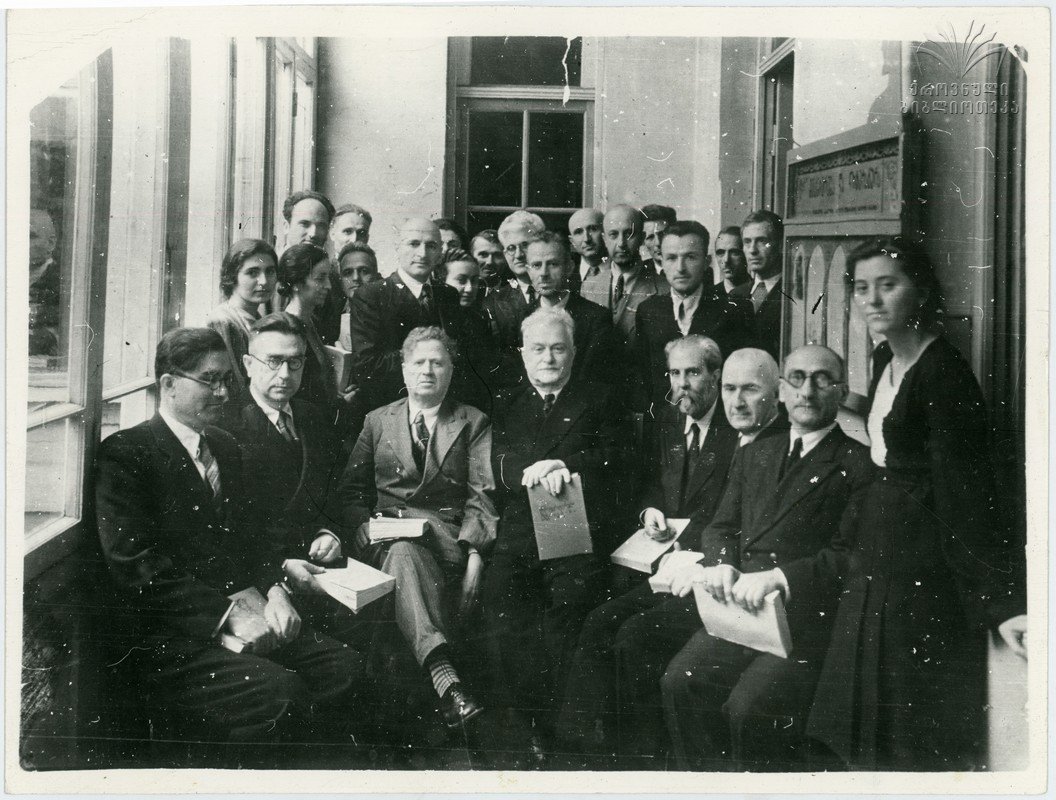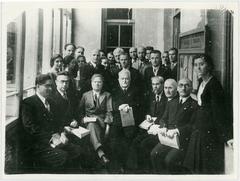
Georgian National Academy of Sciences: Visiting Hours, Tickets, and Historical Guide for Tbilisi
Date: 14/06/2025
Introduction
Situated proudly on Rustaveli Avenue in central Tbilisi, the Georgian National Academy of Sciences (GNAS) is a distinguished symbol of Georgia’s scientific excellence and cultural identity. Founded in 1941, the Academy has been pivotal in advancing research, safeguarding intellectual traditions, and contributing to both national and international scientific communities. Its imposing Stalinist Empire-style building, crowned by a 55-meter tower, is an architectural highlight of Tbilisi’s urban landscape. This guide provides visitors with detailed information on GNAS history, visiting hours, ticketing, accessibility, guided tours, nearby attractions, and practical travel tips.
(council.science, science.org.ge, ALLEA PDF)
Table of Contents
- History and Foundation
- Architectural Highlights
- Visiting Hours and Ticket Information
- Museum of Geophysical Sciences
- Guided Tours and Accessibility
- Events and Exhibitions
- Nearby Attractions and Travel Tips
- FAQs
- Conclusion and How to Plan Your Visit
- References
History and Foundation
The GNAS was established in 1941, following decades of scholarly development rooted in earlier institutions such as the Georgian branch of the All-Union Academy of Sciences and Tbilisi State University. Its intellectual lineage traces to medieval academies like Ikalto and Gelati, reinforcing its status as an inheritor of Georgia’s ancient scientific traditions. The Academy quickly asserted autonomy and became the central hub for fundamental research in the natural sciences and humanities, especially during Soviet times. Today, it continues as the nation’s foremost scientific institution, actively fostering research and international collaboration.
Architectural Highlights
Exterior and Urban Context
The GNAS building, designed by architects M. Chkhikvadze and K. Chkheidze after a 1946 competition, is a masterpiece of mid-20th-century Georgian architecture. Its five-story façade, constructed from pinkish-golden Bolnisi tuff and Borjomi granite, stretches along Rustaveli Avenue and is anchored by a dramatic 55-meter corner tower with a belvedere and spire. The open arcade on the ground floor serves as a public promenade and connects to a central courtyard.
Decorative Features
The façade incorporates traditional Georgian motifs and eclectic decorative elements, such as an openwork parapet, ornate cornices, and an airy arch in the tower. The building’s layout includes administrative offices, lecture halls, and a library housing rare manuscripts and scientific collections.
Visiting Hours and Ticket Information
- Main Building: The GNAS operates primarily as a research and administrative institution. The building’s exterior and ground-level arcade are accessible at all times, offering a unique architectural experience even outside of official events.
- Public Events: Entry to public lectures, exhibitions, and special events is usually free, though some may require advance registration or a nominal fee.
- Museum of Geophysical Sciences: Located nearby at 150a D. Agmashenebeli Avenue, the museum charges a small entrance fee (approx. 5 GEL). Children under six, museum employees, ICOM members, people with disabilities, and refugees may enter free of charge.
Recommendation: Always check the official website or contact the Academy directly for the latest schedules and event information.
Museum of Geophysical Sciences
A highlight for visitors, the Museum of Geophysical Sciences displays historical meteorological and seismological instruments, synoptic maps, and scientific literature dating back to the 18th and 19th centuries. Housed in the historic Tbilisi Geophysical Observatory building, the museum provides a fascinating look at Georgia’s contributions to earth sciences.
Guided Tours and Accessibility
- Guided Tours: Available in Georgian, Russian, and English by advance arrangement. Tours cover the Academy’s history, architecture, scientific achievements, and access to special collections.
- Accessibility: The main building and museum offer wheelchair access, with ramps and elevators in key areas. For specific needs, contact the Academy in advance.
- Photography: Allowed in public areas unless otherwise restricted during official events.
Events and Exhibitions
The Academy regularly organizes public lectures, academic conferences, and special exhibitions. Notable events include the Academy’s 80th anniversary and commemorative exhibitions on prominent Georgian scientists. Upcoming events and details are published on the Academy’s news page.
Nearby Attractions and Travel Tips
Take advantage of the Academy’s central location to explore nearby sites:
- Georgian National Museum
- Tbilisi Opera and Ballet Theatre
- Georgian National Gallery
- Tbilisi State Academy of Arts
- Freedom Square and Rustaveli Avenue’s shops/cafés
Travel Tips:
- The best time to visit is during spring or autumn, when the weather is pleasant and cultural activities abound (tripjive.com).
- Dress respectfully, especially during official events.
- English is increasingly spoken among staff, but Georgian and Russian are prevalent.
- Always check for event announcements and arrange guided tours or group visits in advance.
Frequently Asked Questions (FAQs)
Q: What are the standard visiting hours?
A: There are no regular public visiting hours; access is typically during public events or special exhibitions. Always check the official website.
Q: Are tickets required?
A: Entry is free for public events; some exhibitions or tours may require advance registration or a nominal fee.
Q: Is the building accessible to visitors with disabilities?
A: Yes, though some historic areas may have limited access. Contact the Academy for specific accessibility arrangements.
Q: Can I take photographs?
A: Photography is allowed in public spaces unless restricted during official events.
Q: How can I arrange a guided tour?
A: Email or call the Academy at least two weeks in advance for group or individual tours.
Conclusion and How to Plan Your Visit
The Georgian National Academy of Sciences is an essential destination for those interested in Georgia’s scientific achievements, architectural heritage, and cultural history. Whether you’re attending a public lecture, exploring the museum, or simply admiring the building’s façade, GNAS offers a meaningful and educational experience. For a seamless visit, plan ahead, check the event schedule, and consider guided tours to enrich your understanding of this iconic institution.
Enhance your trip by downloading the Audiala mobile app for guided tours and up-to-date visitor information. Explore Rustaveli Avenue’s vibrant cultural landscape, and immerse yourself in the intellectual spirit that defines Tbilisi.
References and Further Reading
- Georgian National Academy of Sciences – Council Science
- Georgian National Academy of Sciences – ALLEA PDF
- Georgian National Academy of Sciences – science.org.ge
- Georgian National Academy of Sciences – Official Website
- Museum of Geophysical Sciences – Madloba.info
- Georgian National Academy of Sciences – InterAcademies
- Explore Tbilisi Museums and Galleries
- Map of Georgian National Academy of Sciences
- TripJive – Best Time to Visit Tbilisi
- Broken Boots Travel – Things to Do in Tbilisi
































